Even if you don’t like brinjal, I am so sure that this recipe of Vangyachi Bhaji is going to change that feeling of yours to something positive. Also referred to as Vangi Bhaji, this Brinjal dish is a simple, easy and tasty dryish-curry made with eggplant (baingan or aubergine or eggplant), ground peanuts and some spices. This is typically the way this recipe is made in Maharashtra. Hence, the name too is a regional one. The preparation is lightly spiced, sweet and tangy. Thus, makes for a delectable side dish dal-rice, varan-bhaat or even chapatis. The recipe is vegan too.
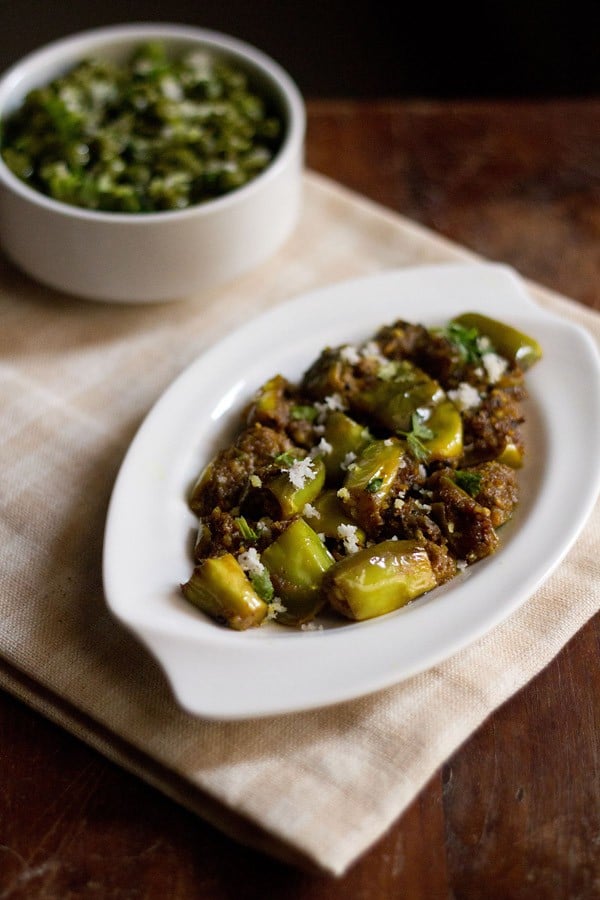
What is Vangyachi Bhaji
Vangyachi Bhaji or Vangi Bhaji is basically the Maharashtrian term for a baingan ki sabzi. Eggplant, brinjal or aubergine is called as ‘baingan’ in Hindi and ‘vangi’ or ‘vangya’ (plural) in Marathi languages. And ‘bhaji’ is essentially a ‘sabzi’ or ‘vegetable preparation.’ Hence, the dish is aptly named so.
In addition to the brinjals or eggplants (vangya) in this Vangyachi Bhaji recipe, most of the ingredients that are used are your usual ones that are available at any Indian home kitchen.
However, to give it an authentic Marathi touch, the dish also uses the goda or kala masala. If you are unable to source it from the market or online, refer to this recipe of Goda Masala and make this spice powder at home.
I recommend using the goda masala only, instead of garam masala to have a traditional flavor in the dish.

Other ingredients that go in the making of this Vangyachi Bhaji are peanuts, grated coconut and red chili powder. You can use either fresh or frozen coconut. The list of tempering ingredients are mustard seeds, turmeric powder and asafoetida (hing).
This Maharashtrian style baingan ki sabzi also has slight sweet and sour tones, due to the addition of a bit of jaggery and tamarind.
These soft succulent cooked aubergines coated with peanut powder and the spices make for an excellent side dish. This recipe is also a no onion, no garlic recipe and thus as satvik preparation.
More on Vangi Bhaji
This Vangyachi Bhaji recipe has been adapted from the cookbook ‘Ruchira Selected Maharashtrian Vegetarian Recipes” by Kamalabai Ogale. This book features a classic collection of selected Maharashtrian vegetarian recipes.
If you are fond of Maharashtrian food that is comforting and easy to prepare, then this book is helpful.
The English version is a thin book and not all, but most of the everyday Maharashtrian recipes are covered. However, if you consider referring to this English version, then I would only suggest it to an experienced home chef.
Since this version of the cookbook has measurements in ‘vati’ (bowl) and not cup measurements, it can be difficult for anybody or everybody to comprehend these. But if you are an experienced one, then you can covert these easily and make the dishes.
Apart from this Vangyachi Bhaji, if you want to try out more of such Maharashtrian dishes, then you can refer to another cookbook called “The Essential Marathi Cookbook” by Kaumudi Marathe. This book has both vegetarian and non-vegetarian recipes.
There is also the Annapurna cookbook which has other regional Indian cuisines together with Maharashtrian cuisine.
This Vangyachi Bhaji goes extremely well as a side dish with Chapati or Jowar Bhakri or Bajra Roti. You can also serve the bhaji with a dal-rice-pickle combination. I actually love pairing it with the Maharashtrian style Varan Bhaat too.
More Brinjal Recipes To Try!
Brinjal Recipes
Brinjal Recipes
Brinjal Recipes
Brinjal Recipes
Please be sure to rate the recipe in the recipe card or leave a comment below if you have made it. For more vegetarian inspirations, Sign Up for my emails or follow me on Instagram, Youtube, Facebook, Pinterest or Twitter.
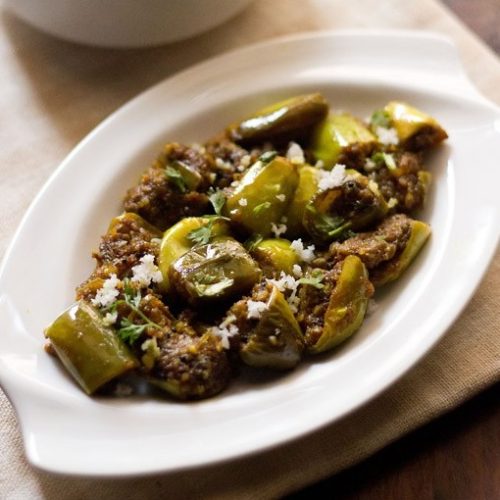
Vangyachi Bhaji | Vangi Bhaji
Ingredients
main ingredients
- 300 grams vangi (brinjals or baingan or eggplants or aubergines) – small or medium-sized
- 1 teaspoon seedless tamarind – soaked in 2 tablespoons warm water
- 2 teaspoon Goda Masala or kala masala
- 2 tablespoon peanuts
- 1 tablespoon coconut – grated, fresh or frozen
- 1 tablespoon jaggery powder or grated jaggery or as required
- ¼ to ½ teaspoon red chili powder or adjust as per taste
- 1 to 2 tablespoons chopped coriander leaves – for garnish
For tempering
- 2 tablespoons oil
- ½ teaspoon mustard seeds
- ½ teaspoon turmeric powder
- 1 pinch asafoetida (hing)
Instructions
Preparation
- Rinse and then quarter the vangi (baingan or eggplants) if they are small or else chop them into medium-sized pieces.
- Place them in salted water for 15 to 20 minutes.
- Warm 2 tablespoons of water and add 1 teaspoon of tamarind in it.
- Soak the tamarind in the water for 20 to 25 minutes.
- Squeeze the tamarind pulp from the soaked tamarind in the soaked water and set aside.
- Roast the peanuts on a pan till they become crisp and have a few black spots on them.
- Once they cool down, grind the peanuts to a powder in a coffee grinder or in a mortar-pestle and set aside.
Making vangi bhaji
- Heat oil in a pan. Crackle the mustard seeds first on low heat.
- Add the asafoetida and turmeric powder. Stir to mix.
- Next add the strained vangi (aubergines) and tamarind pulp. Stir and then cover the pan.
- Simmer on a low heat for 4 to 5 minutes. Do check in between and stir.
- Remove the lid and add red chili powder, goda masala/black masala, jaggery and salt.
- Stir and then cover the pan and let the brinjals cook till soft.
- Do check in between and give a stir.
- If the mixture looks dry, then sprinkle some water if required.
- Once the brinjals are tender, add the peanut powder and sauté for 1 to 2 minutes.
- Check the taste and add more salt, red chili powder, goda masala or jaggery if required
- Lastly add grated coconut and coriander leaves. Give a final stir.
- Serve Vangyachi Bhaji hot with chapati, phulka or as a side dish with dal and rice.
Notes
- Both small-sized or medium-sized eggplants or brinjals work well. But do not make the recipe with the large variety of eggplants that is used to make Baingan Bharta or Vangyache Bharit.
- Easily adjust the spices and seasonings as needed. I do not make this dish spicy, but you can add a bit more red chilli powder.
- Use any neutral flavored oil or can also use peanut oil.
Nutrition Info (Approximate Values)
This Vangyachi Bhaji from the archives first published in February 2014 has been updated and republished on December 2022.
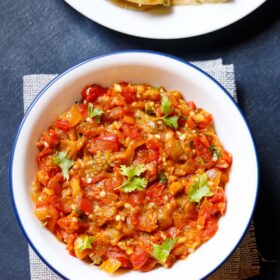
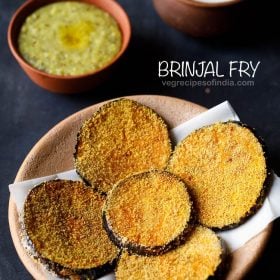

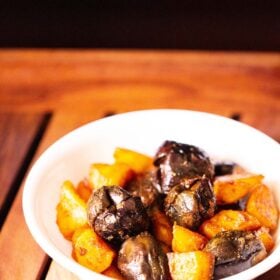
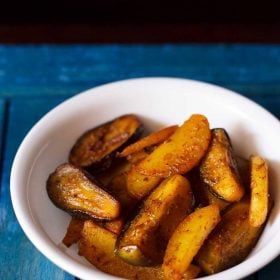









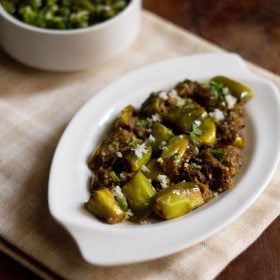
Sounds delicious but what if you cannot get all the ingredients for goda masala?
thanks farz. i have already mentioned what ingredients you can skip. except optional ingredients rest all are needed.
thank you Dassana so much for this blog. i have recently been getting better from depression and cooking many of your recipes has brought me happiness and health.
i have always found recipes very difficult to follow in the past but your friendly way of writing, many pictures, and summary at the end makes difficult dishes seem easy. if you ever publish a book it will never leave my kitchen.
this particular recipe is the most delicious aubergine i have ever eaten! i served it to a guest who also enjoyed it very much. thank you again for your generosity 🙂
welcome liz. your comment is very sweet and touching. at times we all go through depression. but one needs to channelize the energy in positive direction. cooking, baking, gardening, handicrafts are excellent creative activities for women. in my case, whenever i feel low, i read a spiritual book or cook a new recipe or try my hand in baking.
Tried this today. Very tasty and quick to make
thanks hema for the positive feedback.
could you please give me the recipe of the goda masala – just a small quantity will do
thanks,
here’s a recipe which will give a very small quantity.
for the goda masala:
– 1.5 tbsp unsweetened desiccated coconut
– 1.5 tbsp white sesame seeds
– 1 or 2 dry red chilies or byadagi red chilies
– 1 small piece of stone flower/dagad phool (skip if you don’t have)
– 1 tsp cumin seeds
– 2 tsp coriander seeds
– 2 to 3 cloves
– 1 inch cinnamon
– 1 small indian bay leaf/tej patta
– ½ tsp caraway seeds/shah jeera
– 3 to 4 black peppercorns
– a pinch of asafoetida
method:
1. first dry roast all the spices except sesame seeds and desiccated coconut in a pan till they become aromatic.
2. push them towards the sides of the pan. then add the sesame seeds and coconut. mix everything together and roast till the coconut becomes golden.
let this mixture cool and then grind everything in a dry grinder or coffee grinder to a fine powder.
3. store in a small jar and keep in the refrigerator.